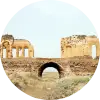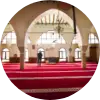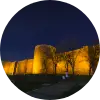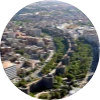
















Hasuni Caves are known as one of the oldest cave settlements in Anatolia.
Situated 6 kilometers east of our district along an international road route, the ancient city in the Hasuni Valley at the southern foothills of Mount Albat overlooks the Silvan Plain.
The Hasuni Caves hold archaeological significance, with a history dating back to the Mesolithic period. During the Neolithic era, people transitioned to a settled way of life and began carving stones for protection and hunting. Hasuni was established during this period.
Consisting of around 300 rooms carved into single rock pieces, resembling a fortress, the Hasuni Caves are unparalleled in Anatolia in terms of area covered and number of caves. Including two churches, the caves are interconnected by corridors. Cisterns, stone-carved water reservoirs, and water channels are found within the caves. At the peak of the rock city, there is a small area reached by a long stone staircase, believed to have been used as a place of offering.
The Hasuni Rock Church, carved into the rocks and consisting of several sections, is one of the oldest temples in Anatolia. Next to the 4-story rock church with a funnel-shaped top, there are 5-step stairs resembling a mini amphitheater, suggesting its use for educational purposes. The Hasuni Rock Church, which has been used as a church from the early spread of Christianity until the 13th century, has been damaged over time.
All walls of the ancient Hasuni Rock Church feature holes and handles carved into the rocks. Additionally, various reliefs carved into the door lintels and window edges can be seen. Built using cut stone and brick, the church is located on a flat area at the edge of the cave city. Although the exact date of construction is unknown, it is believed to be from the 13th century. Colorful cut stones unique to the Silvan region were used in its construction.
The impressive appearance of Hasuni, consisting of cavernous buildings carved into massive rock pieces in the form of apartments, attracts attention. Both local and foreign tourists visiting the area take photographs of the rock stairs, stone-paved roads, rock church, and other historic structures.
Among the caves, in addition to meeting the social and cultural needs of the settlement, structures such as roads, exit stairs, cisterns, water arches, rock churches, weaving workshops, and a church built in the Middle Ages are found.